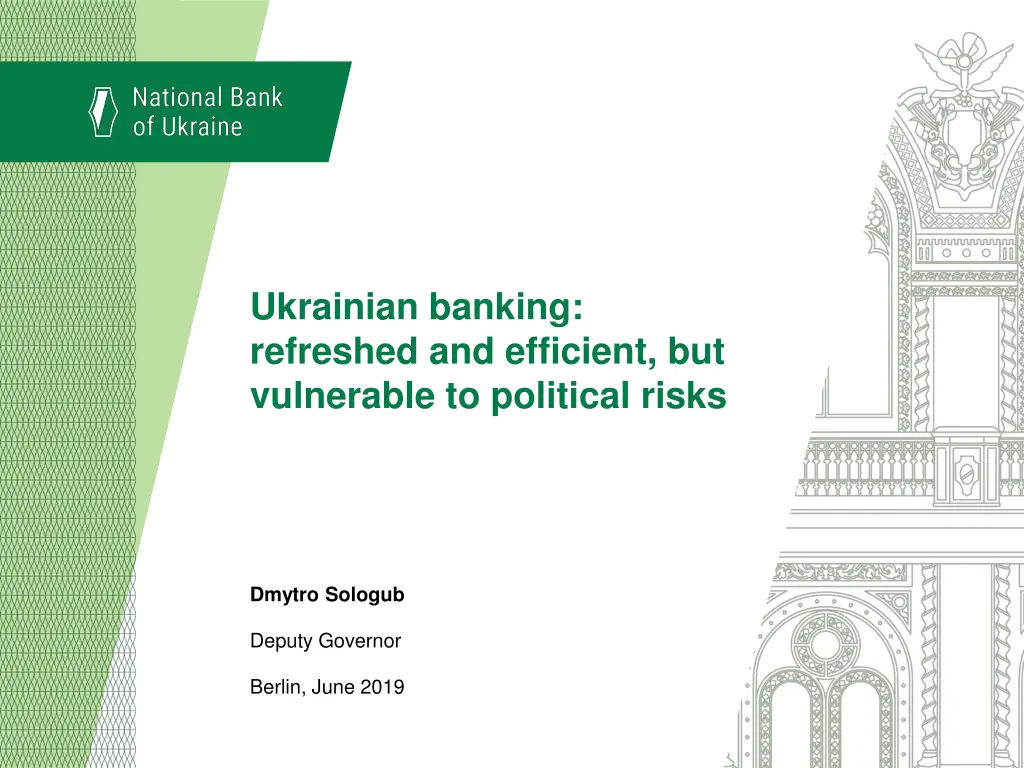
Ukrainian Banking: Vulnerable to Political Risks Amid Macroeconomic Recovery
Discover the refreshed and efficient Ukrainian banking system facing political risks amidst a stable macroeconomic environment. Explore key risks and indicators shaping the future of Ukraine's financial sector.
Download Presentation

Please find below an Image/Link to download the presentation.
The content on the website is provided AS IS for your information and personal use only. It may not be sold, licensed, or shared on other websites without obtaining consent from the author. If you encounter any issues during the download, it is possible that the publisher has removed the file from their server.
You are allowed to download the files provided on this website for personal or commercial use, subject to the condition that they are used lawfully. All files are the property of their respective owners.
The content on the website is provided AS IS for your information and personal use only. It may not be sold, licensed, or shared on other websites without obtaining consent from the author.
E N D
Presentation Transcript
Ukrainian banking: refreshed and efficient, but vulnerable to political risks Dmytro Sologub Deputy Governor Berlin, June 2019
Where we are The next IMF tranche has been postponed until the parliamentary elections and formation of a new government. Macroeconomic policy remains sound. No disruptive issues with banking system. Mild deterioration of FX and business expectations. A key assumption of the macroeconomic and financial sector forecast is that Ukraine will continue to cooperate with the IMF, which will allow to attract other official financing, improve access to the international capital markets and support interest of nonresidents in UAH-denominated bonds. 2
Key risks More uncertainty due to early parliament election External risks ( global recession, decline in commodity prices) Uncertainty over the volume of gas transit through Ukraine in 2020 Escalation of the military conflict and new trade restrictions by RF Risks to Ukraine's financial stability and the NBU s independence 3
Macroeconomic recovery is underway Contributions to Real GDP Growth, pp 10 Headline CPI, % 14 8 12 6 10 4 8 6.3 2 5.0 5.0 6 0 4 -2 2 -4 -6 0 -8 -2 2016 2017 Consumption Net exports GDP 2018 2019 2020 Investment Inventories 2021 IV.17 II.18 IV.18 II.19 IV.19 II.20 IV.20 II.21 IV.21 CPI target band Annual change Quarterly change Source: SSSU, NBU staff estimates. Source: SSSU, NBU staff estimates. Macroeconomic stability has been entrenched amid steady growth recovery and decelerating inflation GDP growth slows down to 2.5% in 2019 but will accelerate in the coming years. Inflation will go down to 6.3% this year and will hit the target in 2020. 4
We dont expect capital outflows, though planned public external debt repayments are challenging Public External Debt Repayments*, USD bn Financial Account (FA): Net Inflows, USD bn 8 10 7 8 6 6 5 4 4 2 3 3.3 3.0 3.0 2.9 2.6 2.4 2 0 1 -2 0 -4 2017 2018 2019 2020 2021 2016 Others Public sector FDI 2017 2018 2019 2020 2021 FX cash outside banks Net private debt flows FA balance (IR April) Others (incl. %) IMF repayments (MinFin, incl. %) IMF repayments (NBU, incl. %) US AID Eurobonds (principal) Eurobonds (%) Eurobonds (principal) * As of April 16, 2019 Source: IMF, -bonds, NBU, Inflation Report April 2019 Source: NBU, Inflation Report April 2019. Stable macroeconomic situation allows NBU to ease FX regulations without negative consequences for capital flows. Connection to ClearStream system launched in 2019. In 2019-2021 due repayments on sovereign debt should exceed to USD 20 bn USD. Cooperation with IMF and other IFI s is vital to assure smooth fulfillment of government obligations. Our baseline scenario implies that cooperation continues. 5
Key macroeconomic indicators 2018 2019 2020 2021 Real GDP, change, % 3.3 2.5 2.9 3.7 Nominal GDP, UAH bn 3 559 3 970 4 342 4 750 CPI, y-o-y, % 9.8 6.3 5.0 5.0 Core CPI, y-o-y, % 8.7 5.0 3.7 3.7 Current account balance, USD bn -4.5 -4.9 -5.8 -6.7 % GDP -3.4 -3.3 -3.6 -4.0 BOP (overall), USD bn 2.9 -0.3 -0.1 -0.7 Gross reserves, USD bn 20.8 21.2 21.9 21.8 Source: Inflation Report, April 2019 6
The NBU is moving towards a currency liberalization Meeting appropriate macro- conditions BEPS principles implementation LIFTING TEMPORARY ADMINISTRATIVE RESTRICTIONS STAGE 0: CURRENT ACCOUNT AND FDI STAGES STAGE1: PORTFOLIO INVESTMENTS AND CREDIT OPERATIONS OF CORPORATES STAGE2: FINANCIAL OPERATIONS OF INDIVIDUALS TODAY Widening funding opportunities and resident s investments for assets diversification TARGET Stimulation of economic growth and productivity FX market Free capital movement and financial system development to support economic growth Transition to the next stage of currency liberalization can be done in case of implementation of OECD recommendations to BEPS resistance and unified standard of automatic exchange of financial information 7
Facing the perfect storm, the National Bank of Ukraine launched a comprehensive reform of the local banking industry Insolvent banks withdrawn from the market Banks recapitalized following AQR and stress-tests AML rules and procedures overhauled Real UBOs disclosed for all banks Unwinding of related-party lending launched Clean-up Business strategy overhaul and management enhancement at state-owned banks Resumption of full-fledged lending by banks Banking sector consolidation Enhancing NPL resolution mechanism Enhanced information disclosure standards Reload Harmonization of banking regulations with Basel recommendations and EU Directives Implementation of effective risk-based banking supervision approach consistent with SREP Enhancement of creditor rights protection Implementing IFRS 9 Sustainable development 2015 2016 2017 2018 2020 Today In addition to the overhaul of the banking system, the NBU simultaneously launched a radical internal transformation 9
Run on banks ends off, the banking system is stable though still dominated by state-owned banks Number of banks Banks total assets by groups, UAH billion 2,000 2015 117 -30 2016 96 -21 2017 82 -14 2018 77 May-19 1,800 51 51 54 Solvent - change State- owned - change Foreign - change Private - change Insolvent - change 76 0 65 1,600 -4 85 21 21 1,400 23 25 1,200 7 0 6 -1 25 0 65 -20 5 -1 23 -2 54 -11 5 0 5 0 25 1,000 800 25 0 85 -30 21 -2 51 -2 1 0 21 0 51 0 1 0 1 5 5 5 600 6 400 6 200 0 12.15 12.16 12.17 12.18 03.19 3 4 1 2 -2 -13 State-owned Privatbank Foreign Private Source: NBU. Solvent banks were grouped under the relevant classification for the given years. Figures - number of banks in each group. Source: NBU. 76 banks operate in the market as of the beginning of June. No new bank bankruptcies over last 1.5 years a smaller number of banks results form M&A and banks reorganizations into financial companies. At present, state-owned banks dominate the market the issue which Ukraine started to resolve in 2018. Government has adopted The Strategy for SOBs, which aims at privatization of state-owned banks. New supervisory boards with independent Directors were appointed, which will lead to corporate governance improvement. 10
The banking system is solvent and profitable Regulatory capital and regulatory capital adequacy Banking system net profit, UAH billion 20 50% 200 20% 7.6 6.6 3.7 10 25% 4.5 3.3 0.7 1.3 150 15% -2.6 -1.5 0 0% 5.3 5.0 3.7 2.5 1.9 -1.8 -3.7 -3.7 -10 -25% 100 10% -23.9 -20 -50% 50 5% -30 -75% I.17 II.17 III.17 IV.17 I.18 II.18 III.18 IV.18 I.19 0 0% of Privatbank, UAH bn of other solvent banks, UAH bn ROE ( . .) 12.16 03.17 06.17 09.17 12.17 03.18 06.18 Tier2 capital ratio (r.h.s.) 09.18 12.18 03.19 Regulatory capital, UAH bn Source: NBU. Source: NBU. Capital adequacy ratios are well above the minimum required level (10% for T1). Banking system returned to profitability in 2018, driven mostly by state-owned PrivatBank, while almost all large and medium-sized banks also reported solid financials (only 13 out of 76 banks reported net losses in 2018). In 2019, the trend continues, net profit for the banking system grew up 1.5x yoy, driven by both interest and commission income growth, LLPs rates are record low (cost of risk less than 2%). 11
Both loans and deposits are growing, mostly UAH-denominated Deposit Developments, 12.2016=100 Loan Developments, 12.2016=100 150 210 80 140 180 70 130 150 60 120 120 50 110 90 40 100 90 60 30 04.19 01.17 07.17 NFC in hryvnia Households in hryvnia NFC in FX (USD equivalent) Households in FX (USD equivalent) 01.18 07.18 01.19 04.19 01.17 07.17 NFC in hryvnia Households in hryvnia Total Loans in FX (USD equivalent) Share of NPL, % (RHS) 01.18 07.18 01.19 Source: NBU. Source: NBU. Strong increase in nominal wages, high interest rates on the back of hryvnia appreciation and improved inflation expectations contributed to the inflow of households' UAH deposits. Consumer loans have been growing fast. Loans to high-quality borrowers with no record of loan default in 2014 2018 continued to grow by more that 25% yoy in 2018. However, high share of NPLs still restrains corporate loans growth. 12
The NPL ratio is still high, but shows a solid downward trend NPL portfolio depending on the ownership of the banks NPL portfolio ratio 65% 100% 86.8% 80% 60% 82.4% 55.2% 60% 51.7% 55% 50.6% 40% 51.7% 50% 24.4% 20% 45% 15.0% 43.9% 0% 03.1706.1709.1712.1703.1806.1809.1812.1803.19 All State-owned Other 40% Privatbank Russian Top-5 Foreign* 06.17 12.17 06.18 03.19 Corporate loans Retail loans All Source: NBU Source: NBU The big share of NPLs is mainly caused by PrivatBank legacy portfolio the companies related to its former shareholders, which stopped to serve their loans shortly after the bank was nationalized in late-2016. The rest of SOBs actively used restructuring tools in 2018. Hope, in 2019 this will be reflected in their statement and results. For private and foreign-owned banks NPL level is moderate and tends to decrease. 13
Key domestic challenges for the banking system Dominance of state-owned banks Still high volumes of NPLs Maturity mismatches between funding and lending prevalence of short-term funding High share of FX-denominated loans and deposits National bank of Ukraine has full capability and competence to properly address these challenges. 14
Key external threats are political uncertainty and politicians attempts to interfere with the NBU s activities Termination of cooperation with IMF Political turbulence Attack on NBU independence PrivatBank case Weakness of judicial system Political uncertainty has already resulted in postponement of the next IMF tranche until parliamentary elections and formation of a new government. Cooperation with the IMF is crucial for successful repayment of external public debt the recent postponement increases the risk of potential fiscal dominance. Some recent decisions of Ukrainian courts bear risks to NBU independence and Ukraine s macroeconomic stability. Ukraine s key partners, including G-7 and leading IFIs have already confirmed they support the NBU s actions and see the NBU s independence as a key factor for financial and macroeconomic stability. The turbulence rises. Safeguarding Ukrainian financial reforms is a duty of all stakeholders. We have to stand together to assure continuation of this path. 15
Web Web Facebook Facebook Twitter Twitter Flickr Flickr Youtube Youtube Instagram Instagram

